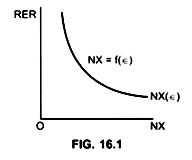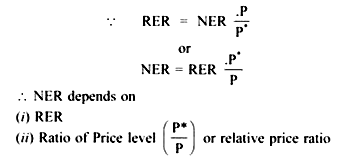Read this article to learn about the Formula for the Calculation of RER!
RER between the two countries is calculated from the NER and the price levels of a given basket of goods and services in the two countries.
There exist direct relationship between RER and the domestic price level (P) but an inverse relationship between RER and P*
RER depends on (a) NER and (b) Relative price ratio.
ADVERTISEMENTS:
RER will increase if NER increases or price of domestic goods increases or price of foreign goods decreases e.g.
If є is high i.e. RER increases → it implies P* < P
Foreign goods are relatively cheap
ADVERTISEMENTS:
Domestic goods are relatively expensive
Imports will increase; exports will decrease, net exports will fall
... NX will be negative
Similarly if є is low → P* > P
ADVERTISEMENTS:
Foreign goods are relatively expensive
Domestic goods are relatively cheap
Exports will increase, imports will decrease thus NX will be positive
It shows that NX is negatively related to RER and therefore NX curve is negatively sloped
Example:
US car costs $ 10,000
Indian car costs Rs. 9,60,000
To compare the prices of the two cars we have to convert them into a common currency.
ADVERTISEMENTS:
If 1 $ = Rs. 48
Then US car costs (10,000 x 48) = Rs. 4,80,000.
Indian car costs Rs. 9,60,000
It means American car costs one-half of what an Indian car costs, that is, at current prices we can exchange two American cars for one Indian car.
ADVERTISEMENTS:
Determination of NER:
Given the value of RER, with increase in domestic price level, NER will decrease, that is, dollar ($) will buy less rupee (Rs.) and vice versa.


